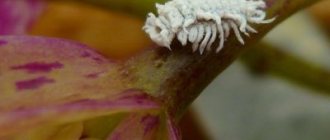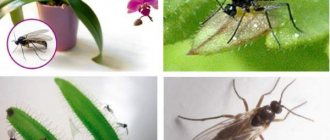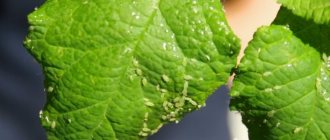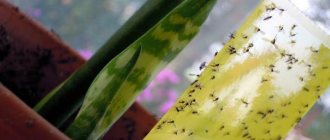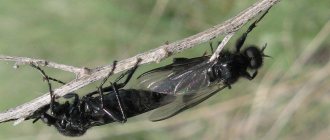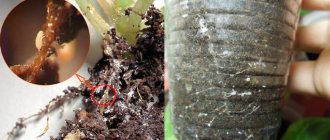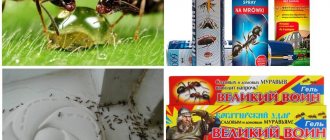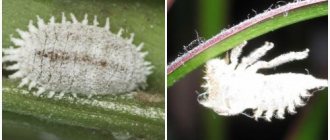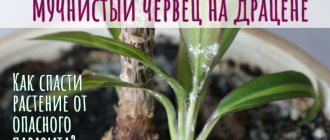How to deal with mealybugs on indoor plants?
Pests on indoor plants give us unpleasant emotions. And we want you to be joyful and cheerful - so look at our tips.
Experts recommend comprehensive control of mealybugs on indoor plants. If the flower is slightly damaged, it is not difficult to fight the pest and you can try using folk remedies, but if the damage is severe, it is better to use drugs.
In any case, to get rid of mealybugs you need to carefully follow the recommendations of specialists and experienced gardeners.
COMBAT MEASURES
- Remove affected leaves or shoots when the pest is detected. If trimming is not possible, then remove all the scale insects with a cotton swab dipped in soapy water.
- Move the affected plant to a separate place, and carefully inspect the rest. Wash the area near the affected flower (window sill, window, outer sides of pots) with soapy water and then with insecticide.
- Replace the top layer of substrate.
- Using a cotton swab, cloth or soft toothbrush, wash the plant with a solution of water and methyl alcohol (1:1), soap solution or tobacco infusion to wash away small mealybugs.
- Rinse off the solution and leave the plant to dry. After the water has evaporated from the leaves, spray the plant and top layer of soil with an insecticide or folk remedy.
- Cover the flower with a bag for 20-30 minutes and rinse it in the shower to wash off the drug and the dead mealybug. If you treated it with a systemic insecticide (Aktara, etc.), then there is no need to wash it off.
- In between treating the plant, wash it every day with water and clean it of parasites.
ADVIСE. Types of plants whose leaves cannot be washed must be sprayed, preferably with preparations.
If the root system is damaged by the pest, carefully wash the roots and trim off the damaged areas, and then transplant the plant into a new substrate.
Treating mealybugs is often a fairly long process that can take 6-12 months.
.
Mealybug close up
.
What types are most common?
Bristly
Externally, such a parasite has an oval body shape with a slight elongation. The color is slightly pinkish or orange with a characteristic white coating. The last pair of ventral setae is longer than the others. A large accumulation of bristle bugs can be observed on the back side and in the axils of the leaves, on the branches of the plant. Belongs to a viviparous species.
Grape
The female has an inherent broad oval shape. This species of mealybugs is most attracted to subtropical climates. Pink or yellow color belongs to this species. The whole body has a coating. It is extremely rare to find males in grape bugs. The emerging larvae occupy the entire plant from shoots to leaves, or rather their main veins. Excretion from scale insects leads to the appearance of sooty fungi in these areas.
Seaside
The most harmful and at the same time common type. The color is gray-pink with a whitish coating. The seaside mealybug has well-developed limbs, which facilitates their rapid movement throughout the plant. Unlike the females of this species, males have wings and move in space throughout the summer.
Females lay offspring in difficult-to-reach places, for example, in the bark of trees, up to 350 - 400 eggs. A feature of the larvae is the absence of a white coating on the body. Seaside mealybug larvae develop into adults within one month.
Citrus
The color of this species is very diverse - from brown to slightly yellow. Female citrus bugs secrete honeydew, i.e. sweet secret. The males of this species, like the seaside scale insects, are capable of flight. The color of males is often pink or yellow.
Popular drugs
We present popular preparations for mealybugs and indicate the hazard (toxicity) class: 4 – low danger to humans, safe for bees and beneficial insects, 3 – moderately dangerous substance, 2 – highly dangerous substance, 1 – extremely dangerous for humans and animals.
We also indicate the active ingredient and approximate prices for the products in Russia.
- “Akarin” (old name “Agravertin”) – 4, (avertin), price: 4 ml package – 13-20 rubles.
- "Aktara" - 3, (thiamethoxam), price: 1.2 ml ampoule - 40-50 rubles, 4 g package - 90-120 rubles.
- "Actellik" - 2, (pirimiphos-methyl), price: 2 ml package - 30-50 rubles. In Russia, the drug for personal use is not registered as of October 1, 2016. Although sometimes the drug can still be found in small stores and on the Internet.
- “Bankol” - 3 (bensultap), price: 10 gram package - 30-40 rubles.
- “Vertimek” - 2, (abamectin), price: 90 dollars/liter, manual packaging - 2 ml - 25 rubles.
- “Inta-Vir” - 3, (cypermethrin), price: 8 g package - 10-15 rubles.
- “Karbofos” (“Malathion”, “Fufanon”) - 3, (malathion), price: 30 g package - 30-40 rubles (strong unpleasant odor).
- “Confidor Extra” - 3, (imidacloprid), price: 1 g package - 30-40 rubles.
- “Tanrek” - 3, (imidacloprid), price: 1 ml ampoule - 10-15 rubles.
- “Fitoverm” - 4, (aversectin C), price: package (ampoule) 4 ml - 15-20 rubles.
- Prices are based on hypermarkets such as “Obi”, “Leroy Merlin” according to the exchange rate of 1 dollar = 65 rubles. These drugs are widely found in many flower shops.
Which drug should I choose?
If the plant is severely infested, getting rid of the mealybug is not easy. You need to try and select an effective insecticide individually so that the pest does not have time to get used to the active substance.
Therefore, look for reliable preparations for mealybugs on indoor plants, which have received positive reviews and recommendations from specialists.
- The Flower Festival magazine recommends starting the fight against mealybugs with the drug Fitoverm, which is as safe as possible for humans and animals, or Aktara, a powerful systemic insecticide.
If these drugs are not found or their effectiveness has decreased, then use Inta-Vir or Tanrek/Confidor. All of these drugs can be alternated if necessary.
And in case of serious damage or weak effects of previous drugs, use “Actellik” or “Karbofos”, “Vertimek” as they are more toxic.
Karbofos, Vertimek and Actellik can only be used to treat indoor plants outdoors.
ATTENTION! Carefully read the instructions for use of any drug and follow the manufacturer's recommendations.
Now you know an effective remedy for mealybugs on indoor flowers, and we will take a closer look at some of them.
"Fitoverm" from mealybug
"Fitoverm" is a popular and effective remedy in the fight against mealybugs. In many situations, it helps well to get rid of pests on indoor plants.
We recommend that flower growers who want to use low-toxic preparations use it first.
"Fitoverm" is an insectoacaricide of biological origin with minimal danger to humans and domestic animals.
- To get rid of mealybugs, dissolve 2 ml of the drug in 200 ml of water and spray the indoor flower. Treatments are carried out every 5-8 days depending on the size and age of the home plant, as well as air temperature.
In most cases, 3-4 procedures are sufficient. Some gardeners treat mealybugs with Fitoverm every 5 days three times and completely destroy the pest.
A week after the last or next spraying with Fitoverm, the plant can be treated with Epin to support the indoor flower.
"Aktara" from mealybug
Aktara is a very powerful systemic insecticide that kills mealybugs in most cases.
An indoor flower is sprayed with an Aktara solution of 1 gram per 1.25 liters of water (enough for 25-30 plants) and the soil mixture is spilled - 1 gram per 10 liters of water.
The procedure must be carried out 2-4 times, every 10-12 days, depending on the air temperature. In most cases, after 2-3 procedures, it is possible to remove the mealybug.
After spraying the flower, there is no need to rinse off Aktaru. The waiting period when spraying is 1-24 hours, and when watering is 2-4 days.
By simultaneously spraying and watering the soil with Aktara, the active ingredient of the drug (thiamethoxam) kills mealybugs on home flowers.
"Confidor" from mealybug
To destroy mealybugs, you can use “Confidor”: dilute 1 gram of the drug in 500 ml of water (1 ml per 2.5 liters of water) and spray the plant with the top layer of soil.
According to reviews from flower growers, the mealybug dies after 3-4 hours, and the product does not harm the plants. Additionally, it is better to water the soil with a solution that is twice as weak.
Drug for severe damage: “Actellik”
Dilute an ampoule (2 ml) in a liter of water and spray when the mealybug appears. No more than 2-3 treatments in a row. The waiting period is 3 days.
IMPORTANT! Actellik can only be used outdoors. Pregnant women, people suffering from asthma and allergic diseases should not use it.
Drug treatment plan
- Treat the plant with insecticides 3-4 times every 7-8 days at an average daily temperature of 22-24°, and when the temperature is higher (25-28°), then after 5-6 days. At an average temperature of 15-20° - 8-10 days, and if below 15° - 10-12 days.
- If the air temperature at the time of treatment is below 18°, then the effectiveness of preparations against mealybugs is significantly reduced and there is little point in spraying indoor plants.
- After spraying, there is no need to put a transparent plastic bag on the plant; it is much more important to re-treat it at the right time.
- A single treatment with any drug will give an immediate effect - therefore, you need to fight the mealybug systemically.
IMPORTANT! If a mealybug is detected, it is advisable to treat all indoor plants; if you treat only part of the home collection, then there is a high risk of the pest being detected again.
ADVIСE. These control measures are also suitable for the control of false scale and scale insects.
How to properly treat plants with drugs?
- Personal protection measures (skin, respiratory organs) when working with chemical preparations against mealybugs. After the procedure, wash your hands and face with soap, and rinse your throat and nose with water.
- Treat indoor flowers only when they are dry.
- The best processing time is before 12.00. On a cloudy day, until 14.00. During and after spraying, until the plant dries, direct sunlight should not fall on it.
- The optimal temperature is 20-26 degrees Celsius.
- The place for treating a flower with drugs of the 3rd and 4th hazard classes can be a balcony or a bathroom, and drugs of the 2nd class can only be used outdoors.
- To maximize the effect of spraying with the product, it is recommended to add liquid potassium soap to the solution.
- Be sure to ventilate the room well after using medications.
IMPORTANT! Carefully read the instructions for the drug - consumption rates may differ from those given above, since they are often produced in liquid and dry form, in different concentrations of active ingredients or package sizes.
Description of the insect
The male resembles a common mosquito. Its body is covered with a white waxy coating. At the end of the insect's abdomen are long antennae. The male insect has wings, and in most cases they are located almost near the head. It is surprising that the males of this genus do not feed; they have absolutely no apparatus for eating.
The female has an unusual oval-oblong shape, which is divided into three main parts - the abdomen, chest and head. The front of the female is more convex compared to her abdomen. Females have three pairs of small limbs, but there are also species where females remain without moving limbs throughout their lives. The female’s body itself is also covered with wax powder, which can be placed either evenly or chaotically. In addition, they have an oral apparatus, which is a sucking organ.
Tick and flea repellent
Flea and tick repellents with the active ingredient imidacloprid (finpronil, cypermethrin) effectively help get rid of mealybugs on indoor plants. For example, drops - “Advantix” (550 rubles), “Avanpost” (250 rubles).
After 1, 2, 3 points from the general instructions.
- Mix the drops with water: a small pipette in 500 ml, and a large pipette in a liter of warm water.
- Moisten the leaves, axils, petioles and stem of the plant, as well as the top layer of the substrate, with this emulsion on both sides.
- After the solution has dried, ventilate the room. The solution does not need to be washed off, and if the odor is strong, it can be washed off every other day with water.
As a rule, one procedure is enough; if necessary, repeat after a week.
If you cannot re-process the plant, then you can cover the pot with the plant with a bag (garbage) and leave a gap. Spray the plant with Bolfo aerosol (400 rubles) for 3-4 seconds, tie the bag and leave the flower for 24 hours - the mealybug will suffocate.
IMPORTANT! Carry out all procedures only in the open air or on the balcony!
- The drugs "Tanrek" and "Confidor" contain a similar active ingredient, so you can safely use them.
Variety of scale insects
There are currently 3 types of mealybugs:
- bristly;
- grape;
- seaside.
Bristly. The body of an adult female is 3.5 mm. It has the shape of an elongated oval, the color is unusual - pinkish or orange. And also the whole body is covered with a white coating. The legs are well developed, it is thanks to them that insects can easily move from one plant to another. Parasites are viviparous. Often these scale insects form a column and are located on the underside of the leaf. They can be found in the axils of leaves, on young tops and shoots.
This type of insect is large and easy to notice on the plant due to its white coating. Leaves that are exposed become damaged and turn yellow over time. All shoots do not die, but at the same time they stop growing. Plants that have been attacked by these insects are very retarded in development.
Grape. The female has an oval body shape, yellow or pink coloring. The legs of the individual are well developed. It is very difficult to meet males; they are very rare. The larvae that are born are located throughout the plant, on shoots and leaves. When the worms manage to attach themselves to the plant, they create a huge colony that sucks all the juices out of the plant.
Representatives of the female sex are engaged in laying eggs in a special pouch. Females often hide from public access; they look for secluded places to hide their eggs. The larvae emerge small and very mobile, their color is yellowish. The larva is completely devoid of waxy coating. When an insect lands on a plant, it spreads throughout it very quickly. This type of scale insect is carried by the wind and is a pest for people and animals.
How to get rid of mealybugs using folk remedies?
Experts have different views on folk remedies in the fight against mealybugs. Many gardeners complain that folk remedies are extremely ineffective and, moreover, can harm the plant.
The editors of the Flower Festival magazine believe that folk remedies for mealybugs can be used in certain situations, since they are safer for humans and animals.
If the degree of damage to the flower is small and there are not many pests, then it is better to start treatment with folk remedies. And also if this is a plant that can be sacrificed, but there is no desire to buy insecticides because of it.
In any case, the use of folk remedies for mealybugs on indoor plants is the personal choice of each gardener, but systemic insecticides are more effective.
1. Soap solution
To prepare a soap solution, household, tar or green potassium soap is suitable, and, in extreme cases, dishwashing detergent is suitable.
It is necessary to treat the entire house plant with a soap solution, as well as the window sill, window frame, pot and pot tray. The more foam in the process, the better.
After wiping the flower, it is better to wash off the soap suds after 2-4 hours.
RECIPE. Pour a tablespoon of soap shavings into a glass of warm water. To enhance the effect, you can add a teaspoon of ammonia (technical, medical, or, in extreme cases, vodka) and 300 grams of water.
The soap-alcohol solution must be washed off after 10-15 minutes with warm water so as not to burn your home flower.
IMPORTANT! Some experts insist that using soap solution on indoor flowers is not permissible. In their opinion, soap blocks the stomata of the plant, which leads to disruption of photosynthesis and plant development.
Plants with delicate leaves should not be treated with alcohol.
2. Garlic
Garlic infusion is a popular folk remedy in the fight against various pests.
Pour a glass of water over five crushed cloves (a teaspoon of pulp) of garlic. Infuse the mixture in a tightly sealed container for 1-2 days, and then wash the plant every 7-8 days. To spray, strain the infusion through three layers of gauze.
Recipe No. 2. A teaspoon of garlic pulp (4-5 cloves crushed) is poured into 500 ml of boiling water and left for 4-5 hours. The infusion is filtered and the affected flower is wiped.
3. Onion
A medium-sized onion is finely chopped, mashed and poured with a glass of water for 2-3 hours. Then everything is the same as with garlic.
ONION PEEKS. To prepare the infusion, pour 20 grams of husk with a liter of warm water and leave for 13-16 hours. The resulting infusion is sprayed on indoor flowers; usually 2-3 procedures are enough to remove aphids.
4. Pepper infusion
Infusion of red hot pepper: boil 20-30 grams of crushed (finely chopped) pepper in 200 ml of water for 60 minutes. Then leave the resulting liquid for 24 hours and strain. To spray, dilute 10 ml of infusion in a liter of water.
You can treat plants with pepper infusion once every two weeks. Pepper tincture can be stored for a long time in its finished form, which allows it to be used very quickly.
5. Oil
Beat 5-10 grams of soap in a glass of water until foam appears, add 15-20 ml of machine oil (2 tablespoons of olive or sunflower). The plant is washed completely with a soap-oil emulsion and left for 6-10 hours, and then washed off.
Carry out 2-3 procedures every 7-10 days. Before treating the plant, cover the soil mixture in the pot with film! Treatment with a water-oil emulsion is not recommended for plants with pubescent, delicate or very thin leaves.
6. Kerosene
In a liter of water, stir 40 grams of household soap (25 grams of green potassium soap) and add five drops of kerosene, and then shake the solution well. The mixture can be wiped or sprayed on the affected areas of the plant.
7. Tobacco
Pour 80 grams of dry tobacco (shag) with a liter of water and leave for 24 hours, then strain and dilute with a liter of water. Then rinse and spray the plant.
8. Calendula
Use a swab dipped in calendula tincture to wipe the affected areas every evening for 3-4 days in a row.
BIOLOGICAL METHOD
To combat mealybugs, some use fungal and bacterial preparations (microbiological), for example, Lepodocid.
Causes of the pest
The period when pests are active is in the winter. For natural reasons, the plant receives less light. This leads to metabolic disorders. A healthy, well-groomed flower rarely becomes a target for parasites. There are several reasons for the appearance of worms:
- non-compliance with temperature conditions;
- low air humidity;
- abuse of nitrogen fertilizers;
- high soil moisture;
- untimely removal of dead leaves and flowers.
All of these problems lead to changes in the concentration of plant juices. Such changes contribute to a sharp increase in the parasite population.
Larvae and adults prefer to choose areas of lush greenery for suction - young shoots, leaves, buds. The white cottony coating on the surface of the plant, which is created by parasites, is visible to the naked eye. In addition, a characteristic sign of the appearance of a scale insect is a sugary discharge. If a citrus bug has settled on a plant, then the root system is also affected.
Prevention
Be sure to water the flower when the substrate is dry. The watering depth is 1 cm. If liquid accumulates in the pan, empty it. The pot containing the flower is constantly cleaned of debris and dead foliage. Also regularly wash the shelf with pots using hot water.
In the summer, parasite larvae enter the room due to gusts of wind. For this reason, plants are periodically inspected, and suspicious specimens are isolated from the rest.
New flowers are quarantined: they are placed separately and carefully observed. If there is a suspicion of infection by harmful insects, the orchid is immediately treated with folk remedies or an insecticide solution.

